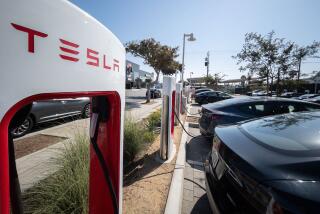Opinion: Can California afford Tesla, and will Tesla want California?
State lawmakers from both parties want Elon Musk to know that they’re ready to open the checkbook to persuade Tesla Motors to put its “gigafactory” battery plant in California. The thing is, it’s not their checkbook, it’s yours.
But maybe they should use it anyway.
According to The Times’ Marc Lifsher, Senate President Pro Tem Darrell Steinberg (D-Sacramento) and Sen. Ted Gaines (R-Rocklin) are pushing a bill that would pledge “financial and regulatory incentives” to speed construction of the plant somewhere in the state. Their proposal, SB 1309, would codify the incentives, although the exact nature of those inducements has yet to be decided.
When Tesla announced plans for the $4 billion to $5 billion gigafactory in February, it identified four states not named California as the possible sites for its investment. California later made it back onto the suitor’s list, and the Brown administration is actively wooing Tesla.
Musk, Tesla’s chief executive, wants the state to provide a quick path over the regulatory hurdles that impede major construction projects. “We can’t afford to wait a year or more for permits to proceed,” Musk told investors, The Times’ Jerry Hirsch reported last month. “If we don’t have the gigafactory online when we have the vehicle capacity online, we would be in deep trouble.”
But even a shortcut through the California Environmental Quality Act isn’t likely to be enough to persuade Tesla to pick a site in the Golden State. That’s because other states (e.g., Texas) not only have a lower cost of doing business, they’re also willing to offer bountiful tax breaks to persuade companies to locate there.
Here’s where your checkbook comes in, albeit metaphorically. When a state offers a sweetheart deal to a taxpayer, less revenue comes in than the state would collect without the deal. Proponents of such incentives argue that they still yield incremental revenue because the company wouldn’t have located in the state otherwise, and that may very well be true. But depending on how the breaks are structured, they can impose real costs.
For example, some states offer tax credits to offset the costs filmmakers incur in making a movie there. Those productions incur little tax liability in those states, however, so the credits are sold to investors, who sell them to other taxpayers there. Although the research has been mixed, most studies have shown that these breaks bring less money into state coffers than they cost in lost revenue.
California, at least, doesn’t pretend that tax breaks pay for themselves. The state has a budget for this sort of thing that puts a price tag on the costs. When it restructured a $750-million tax credit for enterprise zones last year, the Legislature used part of the savings for a new tax credit for investments in manufacturing equipment, and another part for incentives to attract and retain businesses.
Steinberg defended using tax breaks as recruiting tools in an interview Friday. “We have to strike good, hard bargains, but we have to compete,” he said. “So long as it’s clean and they pay people a competitive wage and they’re good employers, we’ve got to compete.”
Note the absence of reference to need. Although Tesla hasn’t been steadily profitable, its share price has skyrocketed over the last year, reflecting investors’ growing faith in the company’s prospects.
And frankly, the state may have little choice but to throw in some hefty tax breaks if it wants to make California as appealing to Tesla as a site in Texas, Arizona, Nevada and New Mexico. Yes, putting the battery plant in California could make it less expensive to delivery batteries to Tesla’s manufacturing plant in Fremont. But in addition to the litigation minefield that is CEQA (which Steinberg managed to streamline only a little last year), the state has among the highest corporate taxes, real estate prices and energy rates in the country.
So why bother? Because manufacturing jobs are in relatively short supply, and they’re unusually valuable to the economy.
Manufacturing provided more than a quarter of all nonfarm jobs in the early 1960s. Fifty years later, the share had dropped below a 10th. Of the 217,000 net nonfarm jobs created in May, the Bureau of Labor Statistics reported Friday, only 10,000 were in manufacturing.
Granted, low-paying service industries tend to rebound faster after a recession than higher-paying goods-producing ones. But the trend has persisted so long in the current recovery, some economists fear that we’re shifting permanently from the latter to the former.
Successful manufacturing plants create jobs not just on the factory floor but outside their gates. That’s because of their demand for parts, tools and supplies. A 2003 paper by the Economic Policy Institute estimated that every manufacturing job supports nearly three jobs elsewhere in the economy, which is a far larger “employment multiplier” than in other industries.
That spillover isn’t necessarily local. And even if a big new manufacturing plant draws companies in its supply chain to set up shop nearby, the latter may not be creating jobs, they may just be moving them from one part of the country to another. But hey, one state’s loss is another one’s gain.
Of course, it’s not much of a win for the state budget if the tax breaks cost more than they generate in new revenue. But the budgetary impact of subsidies is just one way to measure them; a more important metric is whether they actually bring jobs into a state that needs them. And with other states eagerly playing this game, can Sacramento afford not to ante up?
More to Read
A cure for the common opinion
Get thought-provoking perspectives with our weekly newsletter.
You may occasionally receive promotional content from the Los Angeles Times.







